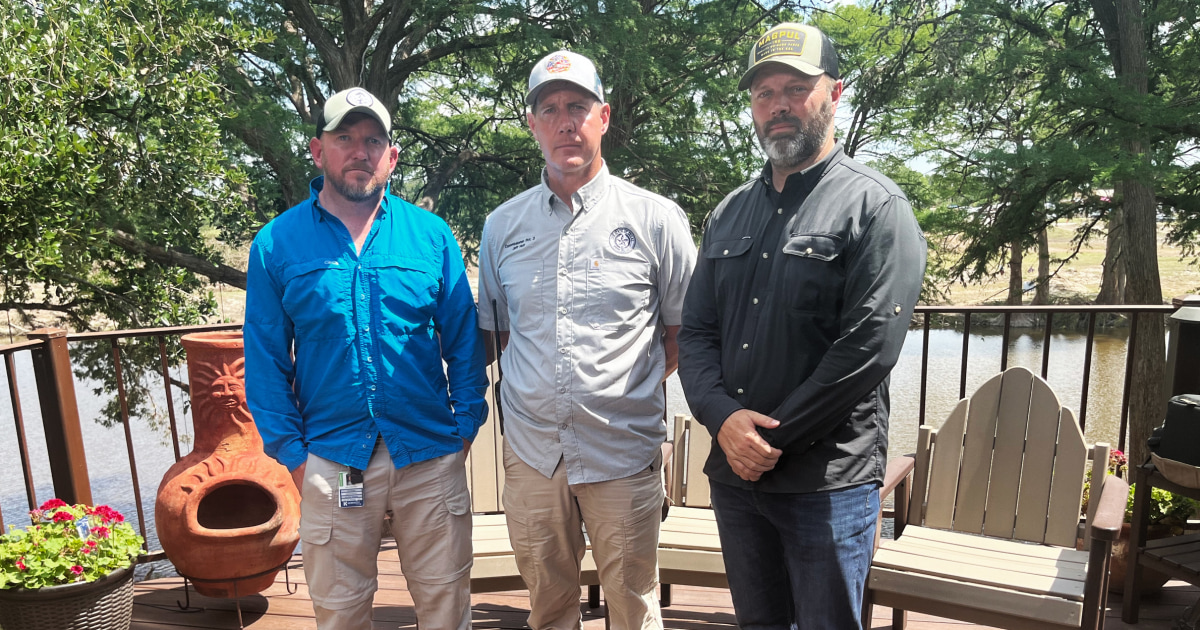‘We saved as many people as we could’

CENTER POINT, Texas — Local and state officials who responded to the catastrophic flooding this month in Central Texas defended their actions in an interview with NBC News, saying they did everything in their power to save lives and are now considering what more could be done to prevent future tragedies.
“Our teams did everything that they possibly could with this gruesome, devastating situation that happened, and we would not change the way we did that. And I think we saved as many people as we could,” Dalton Rice, the city manager of Kerrville, said.
He spoke with NBC News alongside Jeff Holt, a Kerr County commissioner, and state Rep. Wes Virdell, over the weekend, before a new round of heavy rain and flooding threatened parts of the region. The officials said they did their best to coordinate evacuations and rescues against uncontrollable forces of nature, but noted that a permanent emergency operations center, more diversion dams and better cellphone service in certain areas might help save lives in future floods.
Hundreds of people were rescued in the early morning of July 4 as the Guadalupe River surged to unprecedented heights in less than an hour, its intractable current carrying homes and vehicles for miles downstream. At least 132 people died in the flood, including campers and counselors at a girls’ summer camp, and more than 160 people are still missing.
Flash floods are common in the Texas Hill Country, where Kerrville is located, but National Weather Service forecasts predicted less rain than ultimately descended on July 4 — and by the time officials learned that lives were in jeopardy, many homes along the river were already submerged or washed away.
“It happened so rapidly that nobody, nobody could have anticipated it,” Rice said.
Kerr County and Kerrville officials held separate meetings Monday about the ongoing flood response. Officials mostly steered clear of addressing speculation over how leaders communicated about the events on July 4, but one noted that he had received death threats.
Rice told NBC News the water level was normal in his morning run along the river at about 3:30 a.m., during which he planned to survey the Fourth of July festivities. At 5:20 a.m., he started getting phone calls and text messages about the water surging. By that point, evacuations were already underway at campgrounds and RV parks.
Holt, who is also a volunteer firefighter, received an alert from the Center Point Volunteer Fire Department at 4:59 a.m. that help was needed along the river. He had been up with his cat, who was agitated by the storm, for the past hour and a half.
“My cat would not leave me alone, actually scratched my eyeball when I was sleeping,” he said.
In anticipation of heavy rain, some first responders from the Texas Division of Emergency Management were already stationed in the area, along with volunteer swift water rescue teams. Holt assisted with evacuations at around 5:30 a.m. at the Old River Road RV Park in Kerrville, he said, where some people were still fast asleep as the water encroached.
“We all came in to meet probably the hardest day we’re going to see in our lives, and I’m a 30- year combat Marine,” he said.
Virdell, a Republican state lawmaker who represents Kerr County, woke to messages about the flood at around 8 a.m. He got in his car as fast as he could, he said, and drove to the scene from Brady, more than an hour and a half north of Kerrville.
“I just threw, I think, one shirt, some gear or whatever in there, and my wife hopped in with me, and we drove 90 miles an hour,” he said.
Would alerts have made a difference?
In the wake of the disaster, questions have swirled about whether residents were adequately alerted about the dangers facing them, and if such alerts could have made a difference.
Since its approval in 2009, Kerr County has used a phone notification system, known as CodeRed, to deliver emergency messages to residents who opt in. Officials have not said whether CodeRed alerts went out to warn about the weather and evacuations, or who was driving the decision of whether or not to send them.
NBC affiliate KXAN in Austin obtained audio of a volunteer firefighter in the city of Ingram asking a county sheriff dispatcher at 4:22 a.m. if they can “send a CodeRed out to our Hunt residents, asking them to find higher ground or stay home.” The dispatcher responded: “We have to get that approved with our supervisor.”
KXAN reported that one person near a flooded area said they received a voicemail at 1:14 a.m. from a number traced back to CodeRed, while another area resident received a CodeRed alert at 5:34 a.m. about the National Weather Service’s “flash flood warning,” suggesting inconsistencies among recipients countywide.
Parts of the county also have spotty cell service or none at all. Others may not have had their phones with them, like the young girls who were staying at Camp Mystic in the unincorporated community of Hunt, where officials say at least 27 campers and staff members died.
Holt, the Kerr County commissioner, said the county judge and sheriff typically must agree on issuing alerts such as a CodeRed. From his perspective, evacuating people on the ground, he said, “felt like we were all in the fight already, and didn’t need necessarily a call out for it.”
“It’s not easy for anyone, especially if you live on the river and your own home is flooding and you can’t get to the [emergency operations center] because you live on Highway 39, which is the case with a county judge,” Holt added. “He is caught up in the disaster and trying to respond from home as much as possible.”
Kerr County Judge Rob Kelly said at a July 5 news conference that he lives along the Guadalupe River and his properties were devastated by the flood.
As a city manager, Rice said, “CodeRed was not on our mind” at around 5 a.m. when evacuations were underway.
“We were actively communicating with emergency responders in the community,” he added. “It’s very tough to say, would that [alert] have been effective?”
Hours after the flood, Rice helped establish an emergency operations center at the Hill Country Youth Event Center, where state, county and city officials — including the county judge and sheriff — could coordinate their response.
Virdell, the state representative, praised the effort to synchronize local and state operations, noting that two county commissioners worked out of the emergency center while the remaining two assisted with active rescues.
“People know me as sometimes being hard on government, government efficiency. What happened here was one of the most efficient things that I’ve ever seen between all the agencies working together,” he said.
‘They’re just playing a blame game’
Questions over the timeline of events continued Monday as elected officials in Kerr County and Kerrville held public meetings.
“This flood was impossible to accurately and precisely predict,” Mayor Joe Herring said at the end of the Kerrville City Council meeting. He previously said he was awakened to the flooding by a call from Rice at about 5:30 a.m. and received no emergency alerts that morning.
At the Kerr County Commissioners’ Court meeting, residents praised the response from emergency crews amid exhaustive search and rescue operations. Kelly, in his first public appearance since the news conferences immediately after the flood, said he would not be answering questions.
“This is not a press conference today,” Kelly said. “This is a business meeting, and we’ve got business that we have to do in the midst of this disaster response.”
Commissioner Rich Paces said Monday he has received death threats in response to prior actions the county has taken over funding. He clarified that Kerr County received $10 million in federal money from the American Rescue Plan Act, a trillion-dollar Covid relief package signed by President Joe Biden in 2021, but that the money was for a radio system to help with emergency response — not a flood warning system.
“It’s sad to see the evil that’s out there as well. In the midst of all this beauty,” Paces said, referring to the donations and support. “You know, I’ve been getting death threats. Can you imagine, and people cursing us for decisions that we’ve never had a chance to make? And they’re just playing a blame game,” he said.
Lessons learned
More than a week after the flood, state and local officials said they’re focused on recovery operations — including locating the bodies of missing people — rather than identifying any points of weakness in their emergency response.
“Right now I don’t want to spend my time having to go back and look at timelines, because our focus is on the operation,” Rice said.
Holt said the county likely needs more diversion dams to strip off water in the flood zone, an action that would require signoff from private landowners.
And while officials were able to quickly organize an emergency operations center, establishing a permanent one would be a wise long-term solution, he added. He described the need for officials to rehearse for emergency scenarios like flash floods at a single location that’s built for that purpose, “instead of relying on [the Texas Division of Emergency Management] to bring us all together.”
Virdell said it’s also important to find out whether sirens were useful during the disaster, since people sleeping indoors may not have heard them. One resource that may have helped, he added, is better cellphone service along the river in Hunt.
“I’m going to be requesting that some of the cellphone companies work on putting towers in that area,” he said. “I think that’s going to make a big difference because we didn’t have communication with a bunch of the camps.”
A spokesperson for the Eastland family, which owns and operates Camp Mystic, said the camp’s director, Richard “Dick” Eastland, who died that day, received a flood warning from the National Weather Service at 1:14 a.m. on his cellphone. He alerted his family via walkie-talkies, the spokesperson said, but it’s unclear if the camp had means of communicating with authorities other than cellphones. Eastland was last seen evacuating girls from the Bubble Inn cabin, where the youngest campers were staying.
Virdell said he has been looking into whether satellite communication could help generate alerts in coordination with the National Weather Service.
However, he noted, even those tools might not have been enough to avert disaster on July 4: “The general consensus is, everything was done that could be done at that moment.”
Aria Bendix and Morgan Chesky reported from Center Point, and Erik Ortiz from New York.
